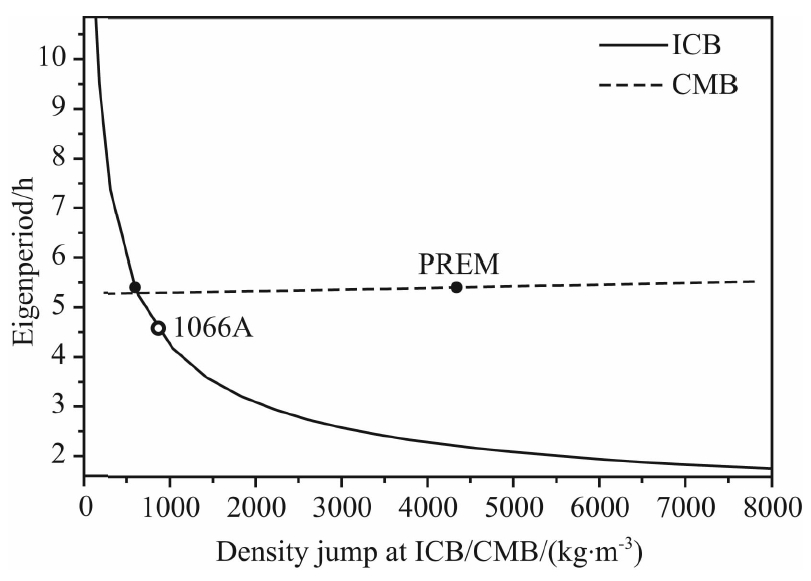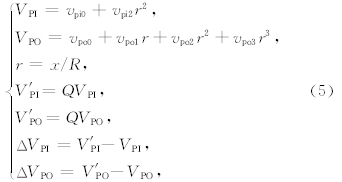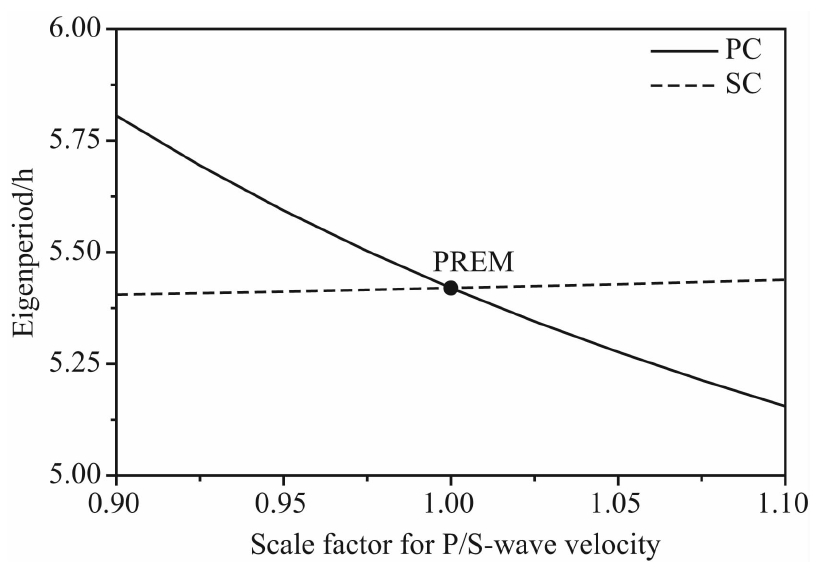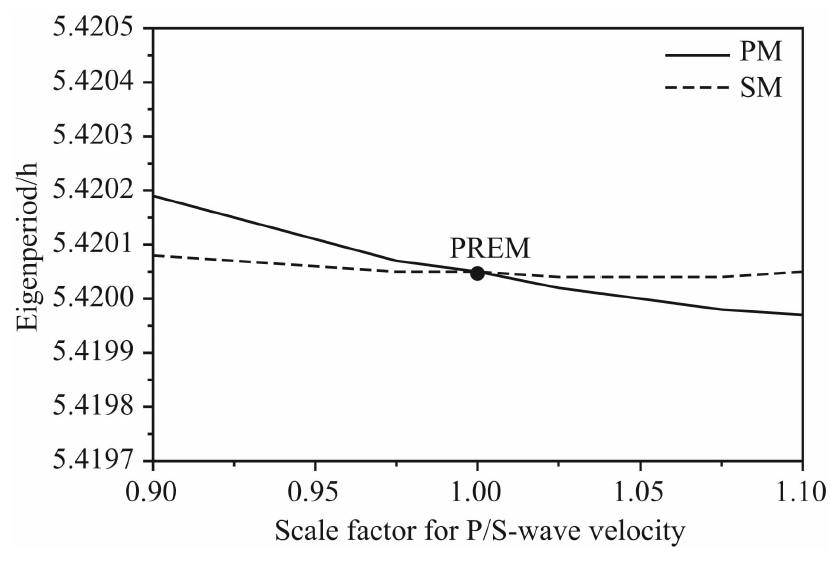2. 中国科学院大学, 北京 100049
2. University of Chinese Academy of Sciences, Beijing 100049, China
1 引言
地球简正模观测和研究是了解地球全球动力学过程和内部结构的基础.一方面,地球的一切受迫运动实际上是各种简正模“共振”运动以特定方式的叠加;另一方面,地球简正模运动综合反映了地球内部介质分布及内部圈层耦合的特征,其观测与研究是认识地球内部结构、物理参数分布和主要圈层耦合机制的重要依据(Wahr,1981).地球固态内核的平动振荡是地球的基本简正模之一,对于非自转、球对称地球模型,简并的Slichter模是周期最长的一阶球型振荡模,由Slichter(1961)首先指出其出现的可能性,又称Slichter模.与传统的地球自由振荡简正模不同,Slichter模不以弹性应力为恢复力,而是以重力(液核流体的浮力)作为主要恢复力,其本征周期大约为几个小时(Xu J Q et al,2005).Slichter模可能是由深部大地震激发的,大地震发生伴随着的地幔一阶球型扰动将导致核幔边界的相应形变,由可压缩的流体外核传递到内外核边界,进而激发Slichter模;也可能是由于液核物质在内外核边界上的非对称结晶导致内核质心的微小变化,地球重力场将驱动内核在其平衡位置附近平动振荡.Slichter模的观测与研究是认识地球受迫运动和内部动力学过程的基础,是了解地球大尺度内部结构、特别是内外核相互作用及其机理的重要依据.
Slichter模的本征周期(频率)可能与地球深内部构造和圈层结构密切相关,许多科学家基于不同 的地球模型研究了Slichter 模的本征周期(Slichter,1961; Xu J Q et al,2005;Busse,1974;Smith,1976;Rogister,2003;Dahlen,1968;Dahlen and Sailor, 1979;Rieutord,2002;Smylie and Rochester, 1981).Busse(1974)假设固态球形内核位于以刚性同心球面为边界的自转、均匀、不可压缩、非黏性流体中心,研究了内核平动振荡,并发现本征周期与内外核密度差(ΔρICB)之间存在非常强的依赖关系.Smith(1976)利用弹性引力运动方程广义球谐函数展开法,基于DG597模型计算了地球平动振荡的本征周期并且理论上研究了自转微椭地球固态内核平动振荡问题.Smith(1976)的数值结果表明液态外核的分层和固体内核的弹性特征对内核平动的本征周期的影响比较显著.Rogister(2003)将本征位移的无穷耦合链分别截取3项和5项,基于PREM模型和1066A模型解算Slichter模的本征周期,并得出了两种截断方式在4位有效数字上保持相同的精度.Rogister(2003)提出如果固体内核处于外核中的刚性平动振荡,那么主要的恢复力是内核的浮力,并且指出内外核密度差对本征周期的影响非常大.Dahlen采用“二阶扰动”理论研究了自转、椭球地球的简正模,详细讨论了由于自转和椭率的谱峰分裂特征并计算得出简并的Slichter模的本征周期(Dahlen,1968;Dahlen and Sailor, 1979).Rieutord(2002)假设核幔边界和固体内核均为刚性的,研究了Slichter模,并探讨了ICB 附近流体的黏性对内核平动振荡(包括谱峰分裂和品质因子)的影响.Smylie和Rochester(1981)采用有限元方法,在“亚地震波”近似的假设下,引入位移势函数,建立液核运动变分原理,分别基于CORE11和1066A地球模型计算了核模.其他一些科学家得到的Slichter模的本征周期的结果都相近(Slichter,1961;Xu J Q et al,2005;Busse,1974;Smith,1976;Rogister,2003;Dahlen,1968;Dahlen and Sailor, 1979),Rieutord(2002)可能是忽略了内核的形变,导致结果和其他科学家的结果差异较大.目前存在的主要问题是由于对深内部地球结构的了解远远不够,相比于地震简正模,Slichter模的本征周期的计算结果相差较大,这种差异主要来自于地球内部结构的哪些因素有待进一步澄清.
本文基于球对称、非自转、弹性和各向同性地球模型(SNREI),讨论地球内部结构的差异对Slichter模的本征周期的影响.分别计算内外核密度差、核幔边界密度差、地核和地幔内P波、S波波速对其本征周期的影响,探讨内部结构的不同差异对Slichter模的影响有多大,进而更好地了解地球深内部结构,更为基于超导重力仪的实际观测资料检测Slichter模提供理论依据(Xu et al., 2010;Smylie,1992;Smylie et al., 1992; Smylie,1999;Rochester and Peng, 1993;Peng,1997;Courtier et al., 2000;Rosat et al., 2003;Sun H P,2004;Rosat et al., 2006;Guo et al., 2006;Ding and Shen, 2013;Shen and Ding, 2013;Jiang et al., 2013;Hinderer et al., 1995).
2 地球内部物理参数的变化对Slichter模本征周期的影响地球内核平动振荡的运动满足相互耦合的Navier弹性平衡方程、Poisson方程和弹性本构方程,采用Alterman 等人(1959)的基本变量代换,即可简化成6阶线性常微分方程组

为研究地球内部密度分布差异对Slichter模本征周期的影响,我们首先讨论内外核密度差对其本征周期的影响.在PREM模型中,内核中密度(ρIC)是半径的二次方程,外核中密度(ρOC)和下地幔中密度(ρM)是半径的三次方程:

在内外核边界的密度突跳为:

 | 图 1 内外核密度差和核幔边界密度差对Slichter模本征周期的影响Fig. 1 Relationship between the eigenperiod of the S lichter mode and the density contrast across the ICB/CMB |
在核幔边界的密度差异为:

| 表 1 地球内部密度分布差异与Slichter模本征周期的变化 Table 1 Differences of interior density and the changes of the Slichter mode′s eigenperiod |
为了研究地震波速对Slichter模本征周期的影响,我们首先讨论在地核中的P波波速变化对Slichter模本征周期的影响.在PREM模型中,内核中P波波速(VPI)是半径的二次方程,外核中P波波速(VPO)是半径的三次方程:

首先讨论在内核中P波波速对Slichter模本征周期的影响,由式(5)改变变化因子Q,使vpi2保持不变,依次调整vpi0的大小来计算不同变化因子Q而引起的速度变化,并计算相应的周期变化,结果如图 2(PIC对应的线型)所示;在外核中,改变变化因子Q,使vpo1、vpo2和vpo3保持不变依次调整vpo0的大小来计算不同变化因子Q而引起的速度变化,并计算相应的周期变化,结果如图 2(POC对应的线型)所示;用相同的方法,得出在整个地核中P波波速改变相应的Slichter模本征周期的变化,如图 2实线所示.在地震学的研究中,一般认为地球内部波速异常的变化范围是±5%,为了方便讨论我们将这个范围扩大一倍,因此令变化因子Q在0.9~1.1范围内变化.由结果可知,随着P波波速的变化因子增大计算得到的Slichter模本征周期缓慢减小.由表 2清晰可知,当内、外核P波波速变化因子相同时,内核P波波速变化引起Slichter模本征周期的变化百分比要略小于外核P波波速变化造成的影响.当波速同样都增加5%时,内核中P波波速的增加使计算得到的周期减小1.019%,外核中P波波速的增加使计算得到的周期减小1.687%,地核中P波波速的增加使计算得到的周期减小2.650%;当 波速同样都增加10%时,内核中P波波速的增加使 计算得到的周期减小1.852%,外核中P波波速的增加使计算得到的周期减小3.227%,地核中P波波速的增加使计算得到的周期减小4.885%;反之,当波速同样都减小5%时,内核中P波波速的减小使计算得到的周期增加1.271%,外核中P波波速的减小使计算得到的周期增大1.847%,地核中P波波速的减小使计算得到的周期增大3.194%;当波速同样都减小10%时,内核中P波波速的减小使计算得到的周期增加2.892%,外核中P波波速的减小使计算得到的周期增加3.865%,地核中P波波速的减小使计算得到的周期增大7.124%.对Slichter模来说,地球内核的运动近似一个刚性的运动.当它在液态外核中运动时,由于流体压力的变化,使其形状有微小的变形,同时,由于内核和外核都是可压缩的,内核在其平衡位置附近的运动导致ICB附近介质的微小的体膨胀,从而使得它们的密度也发生微小的扰动,因此对Slichter模本征周期有影响.
 | 图 2 地核内P波波速变化因子与Slichter模本征周期的变化Fig. 2 Relationship between the scale factor for P-wave velocity in core and eigenperiod of the Slichter mode |
| 表 2 P/S波波速变化因子与Slichter模本征周期的变化 Table 2 The scale factor for P/S-wave velocity and changes of the Slichter mode′s eigenperiod |
在PREM模型中,内核中S波波速(VSI)是半径的二次方程,外核中S波波速为0:

讨论在内核中S波波速对Slichter模本征周期的影响,改变变化因子Q,使vsi2保持不变,依次调整vsi0的大小来计算不同变化因子Q而引起的速度变化,并计算相应的周期变化,结果如图 3虚线所示.同样考虑到实际情况,变化因子Q的变化范围为0.9~1.1,当地核中S波波速变化因子增大时,Slichter模本征周期增大,但是幅度非常小.当波速增加5%时,S波波速的增加使计算得到的周期只增加0.160%;当波速增加10%时,S波波速的增加使计算得到的周期只增加0.335%;反之,当波速减小5%时,S波波速的减小使计算得到的周期只减小0.147%;当波速减小10%时,S波波速的减小使计算得到的周期只减小0.282%.由表 2可以清晰看出,当地核中P波和S波波速变化因子相同时,P波波速变化引起Slichter模本征周期的变化比S波造成的影响要大一个数量级.
 | 图 3 地核内P波和S波波速变化因子与Slichter模本征周期的变化Fig. 3 Relationship between the scale factor for P/S- wave velocity in core and eigenperiod of the Slichter mode |
利用PREM模型,采用相同的方法,只改变地幔中地震波的波速,来讨论地幔中地震波的变化对Slichter模本征周期的影响.由图 4得出,随着P波波速变化因子的增大,Slichter模本征周期减小;而随着S波波速变化因子的增大,Slichter模基本上没有什么变化,更接近于一条直线.由表 2知,地幔 中地震波波速的变化对Slichter模本征周期的影 响非常小,不足0.003%,P波波速变化引起的Slichter模本征周期的变化比S波波速变化的影响略大一点.当波速同样都增加5%时,地幔中P波波速的增加使计算得到的周期减小0.880×10-3%,而S波波速的增加使计算得到的周期减少0.142×10-3%;当波速同样都增加10%时,地幔中P波波速的增加使计算得到的周期减小1.433×10-3%,而S波波速的增加使计算得到的周期增加0.043×10-3%;反之,当波速同样都减少5%时,地幔中P波波速的减少使计算得到的周期增加1.150×10-3%,而S波波速的减少使计算得到的周期增加0.227×10-3%;当波速同样都减少10%时,地幔中P波波速的减少使计算得到的周期增加2.626×10-3%,而S波波速的减少使计算得到的周期增加0.596×10-3%.地球内核平动主要表现为地核中的径向形变,地幔中形变非常小,这也是地幔中地震波速的改变对其本征周期影响较小的主要原因.地球内核平动振荡的运动局限在内核附近,相对来说地幔结构对它的影响很微弱,几乎可以忽略不计.
 | 图 4 地幔中P波和S波波速变化与Slichter模本征周期的变化Fig. 4 Relationship between the scale factor for P/S-wave velocity in mantle and eigenperiod of the Slichter mode |
Slichter模是地球的基本简正模之一,其观测与研究是我们了解地球深内部构造,特别是内外核边界附近密度结构的重要依据.通过上述讨论可以得出以下结论: (1)在地核中,随着P波波速的变化因子增大计算得到的Slichter模本征周期缓慢减小;当波速同样都增加5%时,内核中P波波速的增加使计算得到的周期减小1.019%,而外核中P波波速的增加使计算得到的周期减小1.687%;当波速同样都减小5%时,内核中P波波速的减小使计算得到的周期增加1.271%,而外核中P波波速的减小使计算得到的周期增大1.847%;内、外核P波波速分布异常对Slichter模周期的影响基本相当.
(2)由于液核中S波波速为零,内核主要是平动运动,因此剪切力的影响非常小.在地核中,当S波波速变化因子增大时,Slichter模本征周期增大,但是幅度非常小.当波速增加5%时,S波波速的增加使计算得到的周期只增加0.160%;当波速减小5%时,S波波速的减小使计算得到的周期只减小0.147%.当地核中P波和S波波速变化因子相同时,P波波速变化引起Slichter模本征周期的变化比S波造成的影响要大一个数量级.总体来说,由于内核平动振荡的运动特殊性,地震波的变化对Slichter模的影响非常微弱,之所以有影响是因为内核发生微小形变,在现有的观测条件下是可以不考虑的.
(3)在地幔中,随着P波波速变化因子的增大,Slichter模本征周期减小;而随着S波波速变化因子的增大,Slichter模本征周期先减小后增大.地幔中地震波波速的变化对Slichter模本征周期的影响非常小,P波波速变化引起的Slichter模本征周期的变化比S波波速变化的影响略大一点.地球内核平动主要表现为地核中的径向形变,地幔中形变非常小,这也是地幔中地震波速的改变对其本征周期影响较小的主要原因.相对于局限在内核附近的内核平动振荡,地幔的结构对它的影响微弱,不足0.003%,因此几乎可以忽略不计.
(4)数值结果表明计算得到的Slichter模本征 周期随着内外核边界密度差的增加以类似于双曲线 的特征减小,当内外核密度差减小到200 kg·m-3时,周 期增大66.44%,当内外核密度差增大到1000 kg·m-3 时,周期减小21.48%;Slichter模本征周期随着核幔边界密度差的增大而缓慢增大;1066A模型相对于PREM模型在ICB和CMB的密度差分别相差45.321%和1.132%,但是密度差减小到1066A模型提供的数值时,得到的Slichter模周期与基于1066A获得的结果(4.599 h)非常接近,差异分别只有3.762%和0.037%;也就是说Slichter模本征周期与地球内部介质的精细结构关系不大,但对于内核边界的密度差非常敏感.主要原因是内核平动振荡是地球内核在液态外核中运动,Slichter模以地球引力为恢复力,以流体浮力作为驱动,因此对内外核边界的密度跳跃非常敏感.
由于人们对于地球深内部的了解还远远不够,想要采用现有地球模型准确推算Slichter模周期不是很现实.对Slichter模的观测,有助于约束地球3D结构,特别是内外核密度跳跃.尽管已有不少学者致力于探测Slichter 模(包括三重分裂)(Xu et al., 2010;Smylie,1992;Smylie et al., 1992;Smylie,1999;Rochester and Peng, 1993;Peng,1997;Courtier et al., 2000;Rosat et al., 2003;Sun H et al,2004;Rosat et al., 2006;Guo et al., 2006;Ding and Shen, 2013;Shen and Ding, 2013;Jiang et al., 2013;Hinderer et al., 1995),但尚未出现普遍公认的观测结果.本工作有助于更加深入地了解地球内部结构,从影响Slichter模本征周期的因素入手,得到更精准的地球模型,为基于超导重力仪的实际观测资料检测Slichter模提供理论依据.
致谢 感谢比利时Liege大学的Carlo Denis教授和法国科研中心(CNRS)斯特拉斯堡地球物理研究所的Yves Rogister教授提供有关地球简正模的理论计算软件.
| [1] | Alterman Z, Jarosch H, Pekeris C L. 1959. Oscillation of the earth. Proc. Roy. Soc. A, 252(1268): 80-95, doi: 10.1098/rspa.1959.0138. |
| [2] | Busse F H. 1974. On the free oscillation of the Earth's inner core. J. Geophys. Res., 79(5): 753-757, doi: 10.1029/JB079i005p00753. |
| [3] | Courtier N, Ducarme B, Goodkind J, et al. 2000. Global superconducting gravimeter observations and the search for the translational modes of the inner core. Phys. Earth Planet. Inter., 117(1-4): 3-20, doi: 10.1016/S0031-9201(99)00083-7. |
| [4] | Crossley D J, Rochester M G, Peng Z R. 1992. Slichter modes and love numbers. Geophys. Res. Lett., 19(16): 1679-1682, doi: 10.1029/92GL01574. |
| [5] | Dahlen F A. 1968. The normal modes of a rotating, elliptical Earth. Geophys. J. Int., 16(4): 329-367, doi: 10.1111/j.1365-246X.1968.tb00229.x. |
| [6] | Dahlen F A, Sailor R V. 1979. Rotational and elliptical splitting of the free oscillation of the Earth. Geophys. J. Int., 58(3): 609-623, doi: 10.1111/j.1365-246X.1979.tb04797.x. |
| [7] | Ding H, Shen W B. 2013. Search for the Slichter modes based on a new method: Optimal sequence estimation. J. Geophys. Res.: Solid Earth, 118(9): 5018-5029, doi: 10.1002/jgrb.50344. |
| [8] | Guo J Y, Dierks O, Neumeyer J, et al. 2006. Weighting algorithms to stack superconducting gravimeter data for the potential detection of the Slichter modes. J. Geodyn., 41(1-3): 326-333, doi: 10.1016/j.jog.2005.08.014. |
| [9] | Hinderer J, Crossley D J, Jensen O A. 1995. A search for the Slichter triplet in superconducting gravimeter data. Phys. Earth Planet Inter., 90(3-4): 183-195, doi: 10.1016/0031-9201(95)05083-N. |
| [10] | Jiang Y, Xu J Q, Sun H P. 2013. Detection of inner core translational oscillations using superconducting gravimeters.1 Journal of Earth Science, 24(5): 750-758, doi: 10.007/s12583-013-0370-x. |
| [11] | Peng Z R. 1997. Effects of a mushy transition zone at the inner core boundary on the Slichter modes. Geophys. J. Int., 131(3): 607-617, doi: 10.1111/j.1365-246X.1997.tb06602.x. |
| [12] | Rieutord M. 2002. Slichter modes of the Earth revisited. Phys. Earth Planet. Inter., 131(3-4): 269-278,doi:10.1016/S0031-9201(02)00039-0. |
| [13] | Rochester M, Peng Z. 1993. The Slichter modes of the rotating Earth: A test of the subseismic approximation. Geophys. J. Int., 113(3): 575-585, doi:10.1111/j.1365-246X.1993.tb04653.x. |
| [14] | Rogister V. 2003. Splitting of seismic-free oscillations and of the Slichter triplet using the normal mode theory of a rotating, ellipsoidal Earth. Phys. Earth Planet. Inter., 140(1-3): 169-182, doi: 10.1016/j.pepi.2003.08.002. |
| [15] | Rosat S, Hinderer J, Crossley D, et al. 2003. The search for the Slichter mode: comparison of noise levels of superconducting gravimeters and investigation of a stacking method. Phys. Earth Planet. Inter., 140(1): 183-202, doi: 10.1016/J.PEPI.2003.07.010. |
| [16] | Rosat S, Rogister V, Crossley D, et al. 2006. A search for the Slichter triplet with superconducting gravimeters: Impact of the density jump at the inner core boundary. J. Geodyn., 41(1): 296-306, doi: 10.1016/j.jog.2005.08.033. |
| [17] | Slichter L B. 1961. The fundamental free mode of the Earth's inner core. Proceedings of the National Academy of Sciences of the United States of America, 47(2): 186-190. |
| [18] | Smith M L. 1976. Translational inner core oscillations of a rotating, slightly elliptical Earth. J. Geophys. Res., 81(17): 3055-3064, doi: 10.1029/JB081i017p03055. |
| [19] | Smylie D E. 1992. The inner core translational triplet and the density near the Earth's center. Science, 255(5052): 1678-1682, doi: 10.1126/science.255.5052.1678. |
| [20] | Smylie D E. 1999. Viscosity near Earth's solid inner core. Science, 284(5413): 461-463, doi: 10.1126/science.284.5413.461. |
| [21] | Smylie D E, Hinderer J, Richter B, et al. 1993. The product spectra of gravity and barometric pressure in Europe. Phys. Earth Planet. Inter., 80(3): 135-157, doi: 10.1016/0031-9201(93)90044-A. |
| [22] | Smylie D E, Jiang X. 1993. Core oscillations and their detection in superconducting gravimeter records. J. Geomagnet. Geoelectr., 45(11-12): 1347-1369. |
| [23] | Smylie D E, Jiang X, Brennan B J, et al. 1992. Numerical calculation of modes of oscillation of the Earth's core. Geophys. J. Int., 108(2): 465-490, doi:10.1111/j.1365-246X.1992.tb04629.x. |
| [24] | Smylie D E, Rochester M G. 1981. Compressibility, core dynamics and the subseismic wave equation. Phys. Earth Planet. Inter., 24(4): 308-319, doi: 10.1016/0031-9201(81)90118-7. |
| [25] | Shen W B, Ding H. 2013. Detection of the inner core translational triplet using superconducting gravimetric observations. Journal of Earth Science, 24(5): 725-735, doi: 10.1007/s12583-013-0369-3. |
| [26] | Sun H P, Xu J Q, Ducarme B. 2004. Detection of the translational oscillation of the earth's solid inner core based on the international SG observations. Chinese Sci. Bull. (in Chinese), 49(11): 1165-1176, doi:10.1360/03wd0242. |
| [27] | Wahr J M. 1981. A normal mode expansion for the forced response of a rotating earth. Geophys. J. R. Astr. Soc., 64(3): 651-675, doi: 10.1111/j.1365-246X.1981.tb02689.x. |
| [28] | Xu J Q, Sun H P, Fu R S. 2005. Detection and study of the translational oscillations of the Earth's solid inner core. Advances in Earth Science (in Chinese), 20(7): 740-745. |
| [29] | Xu J Q, Sun H P, Zhou J C. 2010. Experimental detection of the inner core translational triplet. Chinese Sci. Bull., 55(3): 276-283, doi: 10.1007/s11434-009-0479-6. |
| [30] | 孙和平, 徐建桥, Ducarme B. 2004. 基于国际超导重力仪观测资料检测地球固态内核的平动振荡. 科学通报, 49(8): 803-813 . |
| [31] | 徐建桥, 孙和平, 傅容珊. 2005. 地球固体内核平动振荡的研究和检测. 地球科学进展, 20(7): 740-745. |
 2014, Vol. 57
2014, Vol. 57

